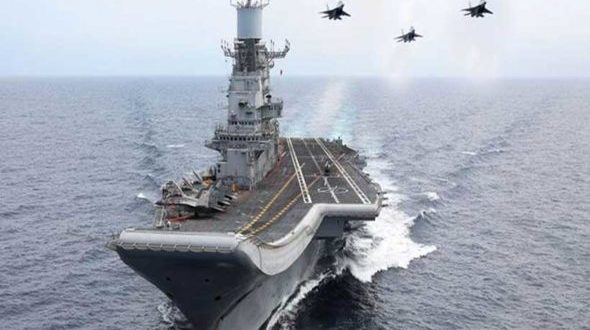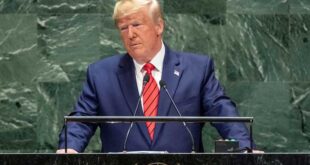The Pacific region in post-Cold-War period is fast changing its strategic complexion. This region had been under United States’ influence. But, the USA and its proxies like India Taiwan, and some other countries perceive that the region is in a state of flux. USA and its allies fear China may in future challenge USA’s undisputed dominance of the seas-lanes in the region.
China’s disputes
China has maritime disputes over some islands in the region (Japan, Vietnam, Brunei, Taiwan, Indonesia, Malaysia and the Philippines). In East China Sea, there is dispute between China and Japan over islands of Diaoyu and Senkakus islands.
The USA assures China’s rivals that USA would be their `security provider’ in moment of need. The major stakeholders in the region ae the USA, China, Australia, ASEAN countries, Japan and South Korea. American presidents Bill Clinton and Barack Obama visited the region to strengthen partnership with littoral states.
The Indo-Pacific region is of great importance because of its impact on energy maritime and trade security. ASEAN and Asia Pacific Economic Cooperation are important politico-economic players in the region. The APEC members account for 40 per cent of world’s population, 54 per cent of the World’s Gross Domestic Product and 44 per cent of the World’s trade. The ASEAN accounts for about 8.8 per cent of World’s population and three per cent of the total and area of Earth.
To block China’s ascendancy, all littoral states including Japan, Australia, Taiwan, South Korea and other middle ranking regional powers are modernizing their navies. China wants to surpass the USA not only in terms of GDP but also in respect of naval power.
India: Emerging us proxy in Indian Ocean
Robert Kaplan, in his book, Monsoon: The Indian Ocean and Future of American Power, argues that the geopolitics of the twenty-first century will hinge on the Indian Ocean. USA’s new protégé is India. To woo India firmly into its fold, USA offered to sell India US$ 3 billion (per one unit) Terminal High Altitude Area Defense (THAAD) and Patriot Advance Capability (PAC-3) missile defence systems as an alternative to Russian S-400 system. India ditched Russia from whom it had decided to purchase five S-400s Russian S-400s air defence systems at cost of US$5.4 billion.
With US tacit support, India is getting tougher with China. There was a 73-day standoff on the Doklam (Donglang in Chinese) plateau near the Nathula Pass on Sikkim border last year. Being at a disadvantage vis-a-vis India, China was compelled to resolve the stand-off through negotiations. In later period, China developed high-altitude “electromagnetic catapult” rockets for its artillery units to liquidate Indian advantage there, as also in Tibet Autonomous Region. China intends to mount a magnetically-propelled high-velocity rail-gun on its 10,000-ton-class missile destroyer 055 being built.
China wants to bridge its aircraft-carrier deficiency through anti-ship ballistic missiles and Xian H-6K bomber armed with advanced air launched cruise missiles. Chinese defence systems include DF-, Dong-Feng 21 (DF-21; NATO reporting name CSS-5 – Dong-Feng (literally: ‘East Wind’). Dong-Feng 21 is a two-stage, solid-fuel rocket, single-warhead medium-range ballistic missile developed by China Changfeng Mechanics and Electronics Technology Academy. A variant is DF-26 with range increased to 3,000 km (1,900 mi) to 4,000 km (2,500 miles). China has two supersonic anti-ship cruise missiles, the YJ-12, with a range of 400 km, and the YJ-18, which can hit targets up to 540 km away. But they are no match for US subsonic
Harpoon anti-ship missile, which has been modified to give it a maximum range of about 240 km. An anti-ship variant of US Raytheon’s Tomahawk land attack cruise missile, with a range of over 1,600 km, has been delivered to the US navy.
At us prodding, India revised its maritime strategy “Freedom to Use the Seas’ in 2015 to “Ensuring Secure Seas”. India obtained access to the US naval base in Diego Garcia, and to the French naval bases in Mayotte and Reunion islands, besides Australian naval base in Cocos (Keeling). It signed an agreement with Seychelles to develop and manage facilities on its Assumption Island, another agreement with Mauritius to develop dual- use logistics facilities in the Agalega Island, obtained berthing rights in Duqm Port in Oman and Maputo in Mozambique. Besides, she took up development of the Sittwe Port in Myanmar as part of the Kaladan multi-modal transit transport project for building a multi-modal sea, river and road transport corridor for shipment of cargo from the eastern ports of India to Myanmar through Sittwe. It upgraded its existing listening post in northern Madagascar.
Chinese navy’s snooping in Indian Ocean is rising (Deccan Herald, March 3, 2019). Upon Indian navy’s protest, Chinese flotilla had to move away from Port Blair. Till 2025, China, currently in grip of corona virus, Bangkok unrest and Xinxiang Uighur, has to do a lot to end American one-upmanship.
China’s thinking
China is suspicious of India’s role as a US proxy in the Indo-Pacific region. It regards the arc from The Bay of Bengal to East China Sea as a hot-spot of rivalry. China’s blue Book warns if India China itself and the USA failed to engage with each other more constructively in view of their overlapping interest, the Indian Ocean could end up `as an Ocean of conflict and trouble’. Chinese Battle Group and submarine often moved in Indian Ocean though after giving prior movement-notice to littoral states.
China has deployed `Xia’ class nuclear submarines with SLBMs in South China Sea. They can reach south-western quadrant of the Indian Ocean via Strait of Malacca or Sunda in a short time.
China is building energy relationship worldwide especially in Central Asia, Russia, Africa, Middle East and Gulf countries.
China gets about 70 per cent of its oil imports from West Asia and Africa through tankers. China is creating a strategic petroleum reserve and is building a fleet of super-tankers for transport of energy to China.
China’s ‘string of pearls’
The USA has over 800 naval bases while China has only two that is Mombasa and Djibouti, aside from controversial Hambantota (Sri Lanka). Yet, the US propaganda is that China is setting up bases along the sea lanes from Middle East to South China Sea. The bases have dual objectives to protect energy and strategic interests.
USA’s ring
Doubtless the USA is the dominant super-power in the Indo-Pacific region. Majority of the littoral states including India. Australia, Taiwan, Vietnam, the Philippines, Spith Koprea are under American influence.
The USA has powerful naval bases at Diego Garcia, Busen, Guyan Island, Yongson base (South Korea) and Okinawa (Japan).The USA has stationed its littoral combat ships at Singapore besides accessing facilities of Vietnamese port Cam Rank Bay.
India’s outreach
The revised Indian Maritime doctrine 2009 states that India wants to build a Blue Water Navy capable of defending not only its homeland d, but also wider security and economic interests in the Indo-Pacific region. In view of South East Asia and South China Sea region, India created regional Andaman and Nicobar Tri-Service Command in 2001 at Port Blair.
India’s Natural gas C Corporation Videsh Limited has oil fields in Russias Sakhalin region. Vietnam allotted two more gas exploration blocks to ONGC-VL during Indian president Pranab Mukherjee’s visit to Vietnam in September 2014.
Indian navy wants to attain underwater nuclear power projection capability by year 2025. By said year, Indian navy will have network-centric approach and land-attack assistance capability. The Indian Regional Navigation Satellite System has become operational since 2016. It will provide positional information of about 1500 kilometers around the Indian mainland.
India is already a partner in the US Security architecture of Indo-Pacific Region. Indian navy’s new acquisition project in the pipeline adds up to well over Rs. 300000 crore over the next 15 years.
Conclusion: Despite adverse advisory opinion on Chagos Island, including Diego Garcia atoll, by International Court of Justice, United States’ forces is still entrenched there. Besides, France maintains naval bases in the Indian Ocean and stations frigates off its Reunion islands. China has a string of naval assets in the region from Gwadar to Djibouti.
India’s ambition to dominate the Indian Ocean does not augur well for the region. It should let Indian Ocean remain the zone of peace.
 Geostrategic Media Political Commentary, Analysis, Security, Defense
Geostrategic Media Political Commentary, Analysis, Security, Defense





